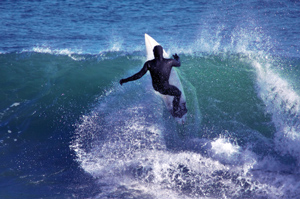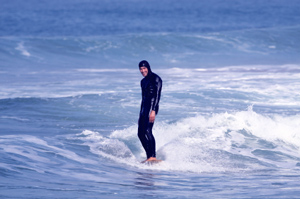How to Prevent Surfer's Ear
 Three thousand. That’s how many hours a surfer needs to log in water colder than 68 degrees to develop external auditory exostosis (EAE) — also known as “surfer’s ear.” This all-too-common condition is caused by repeated exposure to cold water and cold wind. Over time, that combination results in a build-up of bone under the lining of the ear canal that gradually closes off the eardrum. These bony, knob-like growths are the body’s way of protecting the ear from the elements. If untreated, this condition can lead to chronic ear infections, equilibrium issues, and hearing loss.
Three thousand. That’s how many hours a surfer needs to log in water colder than 68 degrees to develop external auditory exostosis (EAE) — also known as “surfer’s ear.” This all-too-common condition is caused by repeated exposure to cold water and cold wind. Over time, that combination results in a build-up of bone under the lining of the ear canal that gradually closes off the eardrum. These bony, knob-like growths are the body’s way of protecting the ear from the elements. If untreated, this condition can lead to chronic ear infections, equilibrium issues, and hearing loss.
Scary stuff, but relax — this guide will provide knowledge and tips for how to avoid surfer’s ear and all of its nasty side effects.
Say When
It’s not a matter of if a hardcore, wetsuit-dependent surfer will experience a constriction of the ear canal, but rather when and how severe it will get before they do something about it. Several studies conducted around the globe have concluded that at least 80 percent of dedicated surfers will develop EAE after ten years of surfing in chilly water, and 90 percent will be afflicted after 20 years.
Experts agree that most cold-water wave junkies have at least some mild bone growths, with one ear usually being affected much more depending on the prevailing wind direction at the breaks they frequent.
Denial
Despite what we know about EAE, many surfers still subscribe to the, “bummer for you, but it won’t happen to me” mentality, or the, “3,000 hours is an eternity, so no need to sweat it now” school of thought. That’s all wishful thinking. Let’s say a cold-water surfer surfs a couple hours per session a few times a week, he could easily be logging a few hundred hours of water time per year. In turn, that same surfer, without taking preventive measures, could be paying a heavy price for all those dawn patrol and epic winter-swell sessions within a decade.
Symptoms of EAE
Here are a few signs that a surfer’s ear canal may be narrowing:
- Increased earwax
- Ears stay plugged for several hours after a session
- Difficulty hearing
- Sensation of water sloshing around in the ear canal
- Ear pain caused by recurring ear infections
Prevention of EAE
 The good news is that surfer’s ear is preventable. Here are five tactics that can help you avoid EAE:
The good news is that surfer’s ear is preventable. Here are five tactics that can help you avoid EAE:
- Use earplugs: Plugs block cold water and air from entering the ear canal. The vast majority of surf shops carry vented earplugs designed for surfers and divers. These plugs let sound in while keeping water out. Make sure you get the proper size to ensure a good seal. Rule of thumb: if some form of neoprene’s required to stay warm, earplugs are probably a good idea too.
- Wear a hood: Neoprene hoods definitely help keep ears warmer, but aren’t as effective as plugs. For best results, go with a hood-and-earplug combo.
- Dry ears out after surfing: Ear, nose, and throat doctors suggest using two to three drops of a mixture of half vinegar and half alcohol to dry out the ear canal and help prevent infection. Using a hair dryer on a low setting after a session can also help.
- Keep ears warm out of the water: If the air is cold — especially if there’s a breeze — pull the hood of a sweatshirt up and/or wear a beanie when checking out the surf.
- Practice fair-weather surfing: The risk of developing surfer’s ear decreases as the water and air temperature increases. So, surfing on a windless and sunny afternoon in the summer, when water temps are generally the highest, will promote less bone growth in the ear canal than a session on a breezy and cold winter morning.
Traditional Treatment
Prevention is key because once these bone growths close up the ear canal, the only way to remove them is through surgery. Yes, that’s right…surgery. The traditional surgical technique is to make an incision behind the ear and drill the bone down into dust. Unfortunately, this involves cutting through a lot of skin, muscle and nerves, which in turn, requires several months of healing time and a long break from surfing.
EAE isn’t discussed much on tropical islands. Much the same, cold-water surfers are six times more likely to get surfer’s ear than those who surf in water warmer than 68 degrees. However, not having to wear a wetsuit usually means dealing with other surfing-related ailments, such as: board rash, reef rash, sea urchin wounds, jellyfish stings, and sunburn. These are all less of a concern at cold-water breaks.
New Treatment Option
Affected surfers can opt for a newer and less invasive chisel technique that was developed in the 1990s. This is still a surgical procedure, but involves entering directly through the ear canal to chip off bone. Although it may seem archaic, chiseling causes much less skin damage and patients can often be surfing again in a matter of weeks after the procedure. There’s also some evidence to suggest that chiseling may cause less bone to grow back in the ear canal after surgery than drilling.
Think Ahead
The bottom line is that surfer’s ear needs to be taken seriously — exceptions coming with those who enjoy the idea of someone taking power tools or chisels to their skull. So think ahead and keep those ears as warm and dry as possible during cold-water sessions; and above all, stay stoked to be out there surfing in the first place!
